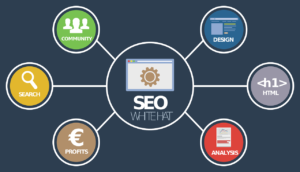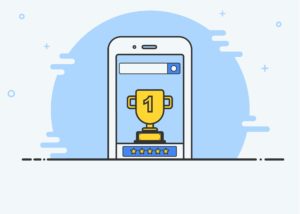Search Engine Optimization, or SEO, is a strategy to help your website to be seen in search engine result pages (SERPs). Years ago, creating a web page and throwing a bunch of keywords on there was good enough to help you get to the top.
People who focused on SEO would create multiple URLs, use redirects, or hide keywords at the bottom of a page that would have links to the site they wanted to drive traffic to. There were also Web directories managed by humans that manually entered websites to be listed, but these could be gamed as well.
SEO is now automated by web crawlers, which are bots that crawl links and help to index the sites into directories like Google, Yahoo, Bing, etc. Artificial intelligence (A.I.) is at the heart of this and it is programmed to learn from our search keywords to interpret what we are truly looking for.
Today, there are a couple of different approaches you can take to perform SEO, white hat and black hat. Black hat strategies are focused on trying to use other channels or tactics that Google does not deem fair, to get organic traffic to your site and usually help to bump things quickly until it’s caught. A black hat strategy is risky and if caught can really hurt your website.
 White hat strategies are focused on playing within the rules and using all avenues to achieve results for long lasting organic growth, usually at a slower, steady pace. These must be continually tweaked to constantly keep up with the shifting rules. A white strategy is a well-refined set of tactics for continued growth without worry of being penalized.
White hat strategies are focused on playing within the rules and using all avenues to achieve results for long lasting organic growth, usually at a slower, steady pace. These must be continually tweaked to constantly keep up with the shifting rules. A white strategy is a well-refined set of tactics for continued growth without worry of being penalized.
So what does it take to achieve organic growth for a business today? As SEO tactics have evolved with shifting technology, so has the practice itself. It’s difficult to see SEO as just optimizing with keywords because it’s become more complex than that. Google has over 200 different signals that are used for ranking, but there are three signals at the top of Google’s ranking list. Since most people use Google for searches around the world, it is the one search engine that SEOs try and rank for. These three large signals are the most important to think about when producing an SEO strategy:
- Content
- Links
- RankBrain
Content
Let’s face it, content is the entire reason we’re all here on the Web searching for things, right? It makes sense that content is also a strong signal for ranking a website. What do the big search engines, like Google, look for though?
People learn in different ways, so there are many types of content that can be used to fit people’s needs while adding value to your site. According to an article from Forbes, they quote a HubSpot report that says 39% of business decision-makers contact a vendor after viewing a branded video. Video is a strong way to connect with visual learners and many Millennials who prefer to watch videos.
Creating fresh, unique content is important because it’s a signal to Google that you’re continuously working on creating content for your customers. It’s also great for consistently sharing new ideas to your fans on social media. Finally, it’s an opportunity to use more keywords to bring people your site.
Graphics, especially infographics, are perfect for disseminating important information in an easy-to-represent picture to get your main points or facts across.
When writing content, it’s important to remember that you are writing for your audience. However, you are also writing for the bots that crawl your site. In general, you want to write meaningful content to your audience, but also include the various keywords that bots are looking for so that your content can be found more readily in searches.
Links
Links are extremely important and there are two types to concentrate on – external and internal.
External links are any links on a website that are not your own, but that link back to your site’s content. These links are signals to many search engines that you have relevant content and are a trusted source. Another great source of external links, especially for the automotive industry, is through third party sources. Ensuring that your business information and site are uniform across all of your local citations will help your organic visibility to your customers.
Internal links are links within your own site that link to other parts of your site. These help to provide better site navigation and to provide extra content. A site crawler, like Googlebot, can use these links to jump around your page and is useful for helping to index. If you use keywords with your internal links, this anchor text is also a stronger signal for keyword authority on your page.
RankBrain
RankBrain is a Google algorithm that helps to interpret what different search queries are looking for. This is where semantic search is valuable and why you should be diversifying your keyword terms. RankBrain is also used for ranking purposes by Google and is one of the top three signals used to determine ranking.

Further Optimizing
SEO in 2017 is very unique because it’s about producing quality content and generating great links from outside sources and using internal sources effectively. In addition to these top signals, a business should be using their Google Business, Google Plus page, and managing local citations.
Furthermore, Google is pushing for a mobile focus. This means that you have to think like a searcher on their mobile device does and incorporate “near me” type searches and place keywords with local areas in your content.
Finally, your online and social reputations are becoming a factor for local ranking. Ensuring that you have good business reviews and are actively responding to customers that have a bad experience shows that you care. Google tends to reward businesses that have a good relationship with their customers. The better your online rating, the more likely you are to be featured in mobile map business listings.
It is for all of these reasons that we must stop thinking of SEO service in 2017 as search optimization, but rather more of a digital facet of public relations and user experience.
Do you have any other questions regarding automotive SEO or general SEO questions? Leave us a comment or connect with our L2TMedia team!

